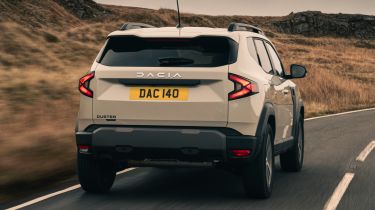Dacia Duster – MPG, emissions & running costs
Adding mild and full-hybrid technology means the latest Dacia Duster is even more efficient than before
Being relatively light counts in the Dacia Duster’s favour when it comes to efficiency. The old Duster could return up to 45.6mpg with the TCe 90 and 130 petrol engines. Thanks to mild-hybrid help, Dacia says the assistance from the 48-volt starter-generator used in the TCe 130 improves fuel consumption to a WLTP figure of 51.4mpg. We managed a respectable 46.3mpg from a two-wheel drive model during testing. Adding four-wheel drive to the 1.2-litre three-cylinder engine reduces its efficiency down to 46.3mpg, so expect this to be around 40mpg in the real world.
The Duster Hybrid is even better, with Dacia claiming it’ll return up to 55.4mpg. That’s not just talk either, as we managed to average 55.2mpg over 250 miles of mainly motorway driving, and with zero hypermiling techniques. It certainly helps that the Hybrid 140 powertrain always starts off in pure-electric mode, and allows the Duster to be driven around town primarily in EV mode.
For those interested in the 1.0 TCe Bi-Fuel, while the 43.5mpg fuel economy figure looks poor thanks to LPG being less energy dense than regular petrol, at least the fuel costs less to buy in the first place – provided you can find a filling station that stocks it, of course.
| Model | MPG | CO2 | Insurance group |
| Dacia Duster TCe 100 Bi-Fuel | 43.5mpg | 126g/km | 17 |
| Dacia Duster TCe 130 | 51.4mpg | 124g/km | 24 |
| Dacia Duster TCe 130 4x4 | 46.3mpg | 135g/km | 24 |
| Dacia Duster Hybrid 140 | 55.3mpg | 114g/km | 24 |
Tax
Thanks to affordable pricing, not even the priciest Duster model breaches the £40,000 limit that would require an additional tax surcharge.
Private buyers will get a small discount going for the Hybrid 140 and 1.0 TCe Bi-Fuel compared with the TCe 130 mild-hybrid petrol version because both are classed as alternative fuel vehicles.
In our view, the hybrid’s CO2 figure of 114g/km could be a little lower, given that the mild-hybrid alternative puts out 124g/km and is likely to cost less to buy than the hybrid. For company car drivers paying Benefit-in-Kind (BiK), the Hybrid 140 is in the 28 per cent band, while the TCe 130 is in the 29 per cent band.
Insurance groups
The entry-level Duster falls into insurance group 17 (out of 50), while the rest of the line-up lands in group 24. Those are higher group rating than previous model, and other small SUVs, but the Duster should still be cheap to insure.
Depreciation
According to our expert data, the Dacia Duster is predicted to hold on to its value better than some of its rivals. After a typical three-year/36,000-mile ownership period, the Duster is expected to hang on to between 56 to 62 per cent of its original value. The entry-level Essential model should retain the most value, while the Duster Hybrid is set to lose the most – though admittedly, not by a huge margin.
In comparison, the Ford Puma and Renault Captur are both expected to hold onto between 51 to 54 per cent of their original value over the same period.




